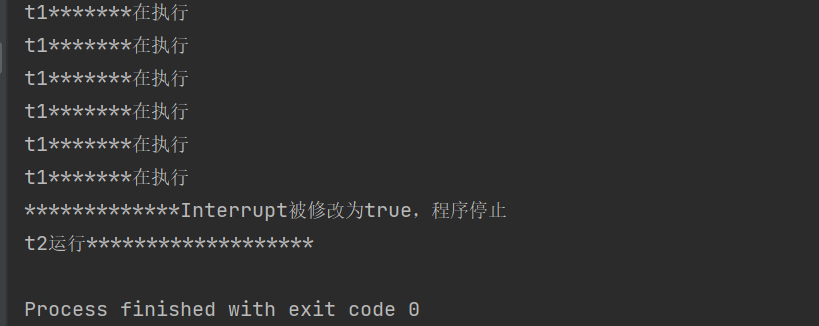一、线程中断机制
1、概述
- 一个线程不应该由其他线程来强制中断或停止,而是应该由线程自己自行停止,所以,Thread.stop、Thread.suspend、Thread. resume都已经被废弃了
- 在Java中没有办法立即停止一条线程,然而停止线程却显得尤为重要,如取消一个耗时操作。因此,Java提供了一种用于停止线程的协商机制 — 中断
- 中断只是一种协商机制,Java没有给中断增加任何语法,中断的过程完全需要程序员自己实现
- 若要中断一个线程,你需要手动调用该线程的interrupt方法,该方法也仅仅是将线程对象的中断标识设为true
- 每个线程对象中都有一个标识,用于标识线程是否被中断;该标识位为true表示中断,为false表示未中断;通过调用线程对象的interru pt方法将线程的标识位设为true;可以在别的线程中调用,也可以在自己的线程中调用
2、API介绍


1、interrupt
源码
public void interrupt() {
if (this != Thread.currentThread())
checkAccess();
synchronized (blockerLock) {
Interruptible b = blocker;
if (b != null) {
interrupt0(); // 底层调用了native方法
b.interrupt(this);
return;
}
}
interrupt0();
}
实例方法,interrupt()仅仅是设置线程的中断状态为true,发起一个协商,而不会立刻停止线程。 当一个线程调用interrupt()时: 1、如果线程处于正常活动状态,那么会将该线程的中断标志设置为ture,仅此而已,被设置中断标志的线程将继续正常运行,不受影响。所以,interrupt()并不能真正中断线程,需要被调用的线程自己配合才行。 2、如果线程处于被阻塞状态(sleep,wait,join等),在别的线程中调用当前线程对象的interrupt方法,那么线程将立即退出被阻塞状态,并抛出一个InterruptedException异常。
2、interrupted
源码
public static boolean interrupted() {
return currentThread().isInterrupted(true);
}
静态方法,判断线程是否被中断,并清除当前中断状态。这个方法做了两件事 1、返回当前线程的中断状态,测试当前线程是否已经被中断 2、将当前线程的中断状态清除,并重新设置为false,取消线程的中断状态
3、isInterrupted
源码
public boolean isInterrupted() {
//false:不需要清除中断状态
return isInterrupted(false);
}
private native boolean isInterrupted(boolean ClearInterrupted);
实例方法,判断当前线程是否被中断
3、终端机制的疑问
1、如何停止中断运行中的线程
1、通过一个volatile变量实现
package com.lori.juc2023.juc4;
import java.util.concurrent.TimeUnit;
public class InterruptDemo {
static volatile boolean isStop = false;
public static void main(String[] args) {
new Thread(()->{
while (true){
if(isStop){
System.out.println("*************isStop被修改为true,程序停止");
break;
}
System.out.println(Thread.currentThread().getName()+":运行中*******************");
}
},"t1").start();
try {
TimeUnit.MILLISECONDS.sleep(5);} catch (InterruptedException e) {throw new RuntimeException(e);}
new Thread(()->{
isStop=true;
System.out.println(Thread.currentThread().getName()+"运行*******************");
},"t2").start();
}
}

2、通过AtomicBoolean
package com.lori.juc2023.juc4;
import java.util.concurrent.TimeUnit;
import java.util.concurrent.atomic.AtomicBoolean;
public class InterruptDemo1 {
static AtomicBoolean atomicBoolean = new AtomicBoolean(false);
public static void main(String[] args) {
new Thread(()->{
while (true){
if(atomicBoolean.get()){
System.out.println("*************atomicBoolean被修改为true,程序停止");
break;
}
System.out.println(Thread.currentThread().getName()+":运行中*******************");
}
},"t1").start();
try {
TimeUnit.MILLISECONDS.sleep(5);} catch (InterruptedException e) {throw new RuntimeException(e);}
new Thread(()->{
atomicBoolean.set(true);
System.out.println(Thread.currentThread().getName()+"运行*******************");
},"t2").start();
}
}

3、通过Thread类自带的中断API实例方法实现
在需要中断的线程中不断监听中断状态,一旦发生中断,就执行相应的中断处理业务逻辑stop线程
package com.lori.juc2023.juc4;
import java.util.concurrent.TimeUnit;
public class InterruptDemo2 {
public static void main(String[] args) {
Thread t1 = new Thread(() -> {
while (true){
if(Thread.currentThread().isInterrupted()){
System.out.println("*************Interrupt被修改为true,程序停止");
break;
}
System.out.println(Thread.currentThread().getName()+"*******在执行");
}
},"t1");
t1.start();
try {
TimeUnit.MILLISECONDS.sleep(5);} catch (InterruptedException e) {throw new RuntimeException(e);}
new Thread(()->{
t1.interrupt();
System.out.println(Thread.currentThread().getName()+"运行*******************");
},"t2").start();
}
}

2、当前线程的终端标识为true,是不是线程就立刻停止
当前线程的终端标识为true,线程不会立即中断
package com.lori.juc2023.juc4;
import java.util.concurrent.TimeUnit;
public class InterruptDemo3 {
public static void main(String[] args) {
Thread t1 = new Thread(() -> {
for (int i = 0; i < 300; i++) {
System.out.println("******************"+i);
}
System.out.println("t1线程调用Interrupt方法后的中断标识(02):"+Thread.currentThread().isInterrupted());
}, "t1");
t1.start();
System.out.println("t1线程的默认标识"+t1.isInterrupted());
try {TimeUnit.MILLISECONDS.sleep(2);} catch (InterruptedException e) {throw new RuntimeException(e);}
t1.interrupt();
System.out.println("t1线程调用Interrupt方法后的中断标识(01):"+t1.isInterrupted());
}
}

package com.lori.juc2023.juc4;
import java.util.concurrent.TimeUnit;
public class InterruptDemo3 {
public static void main(String[] args) {
Thread t1 = new Thread(() -> {
for (int i = 0; i < 300; i++) {
System.out.println("******************"+i);
}
System.out.println("t1线程调用Interrupt方法后的中断标识(02):"+Thread.currentThread().isInterrupted());
}, "t1");
t1.start();
System.out.println("t1线程的默认标识"+t1.isInterrupted());
try {TimeUnit.MILLISECONDS.sleep(2);} catch (InterruptedException e) {throw new RuntimeException(e);}
t1.interrupt();
System.out.println("t1线程调用Interrupt方法后的中断标识(01):"+t1.isInterrupted());
//线程停止后,停止状态又会被变为false
try {TimeUnit.MILLISECONDS.sleep(2000);} catch (InterruptedException e) {throw new RuntimeException(e);}
System.out.println("t1线程调用Interrupt方法后的中断标识(03):"+t1.isInterrupted());
}
}

package com.lori.juc2023.juc4;
import java.util.concurrent.TimeUnit;
public class InterruptDemo3 {
public static void main(String[] args) {
Thread t1 = new Thread(() -> {
while (true){
if (Thread.currentThread().isInterrupted()){
System.out.println(Thread.currentThread().getName()+"\t"+"中断标识位:"+Thread.currentThread().isInterrupted()+"程序停止");
break;
}
//睡一会
try {
Thread.sleep(200);
} catch (InterruptedException e) {
//没有它,此线程不会停止
Thread.currentThread().interrupt();
throw new RuntimeException(e);
}
System.out.println("hello********");
}
}, "t1");
t1.start();
try {TimeUnit.SECONDS.sleep(1);} catch (InterruptedException e) {throw new RuntimeException(e);}
new Thread(()->{
t1.interrupt();
},"t2").start();
}
}

sleep方法抛出InterruptedException异常后,中断标识被置为false,我们在catch没有调用Thread.currentThread().interrupt();将标志设置为true,就导致了无限死循环。
3、静态方法Thread.interrupted(),怎么理解
package com.lori.juc2023.juc4;
public class InterruptDemo6 {
public static void main(String[] args) {
System.out.println(Thread.currentThread().isInterrupted());//false
System.out.println(Thread.interrupted());//false
System.out.println(Thread.currentThread().isInterrupted());//false
Thread.currentThread().interrupt();
System.out.println(Thread.interrupted());//true
System.out.println(Thread.currentThread().isInterrupted());//false
}
}









